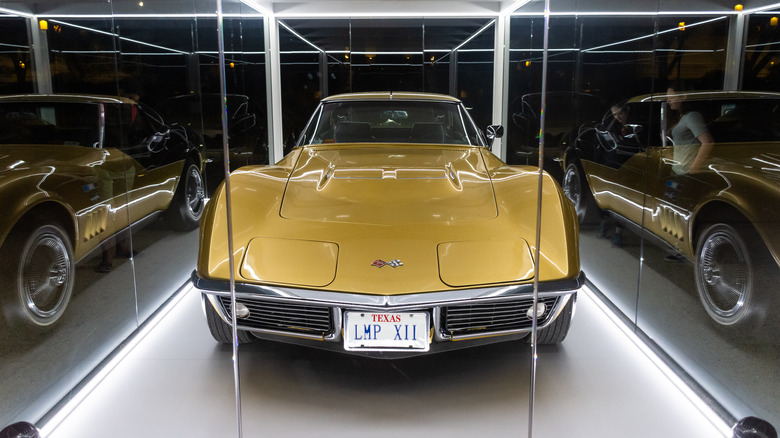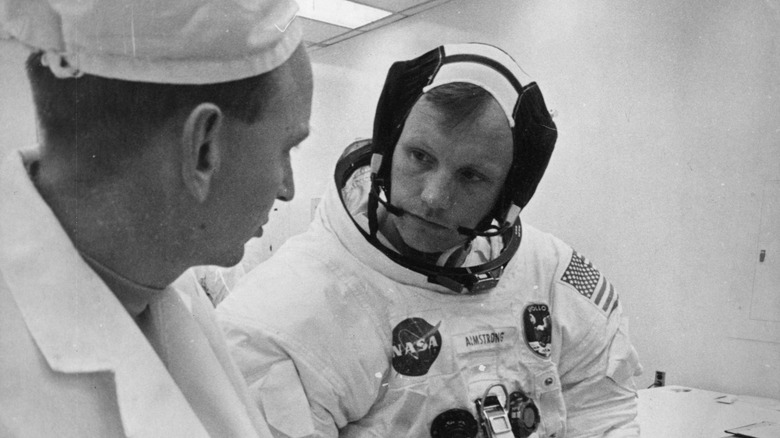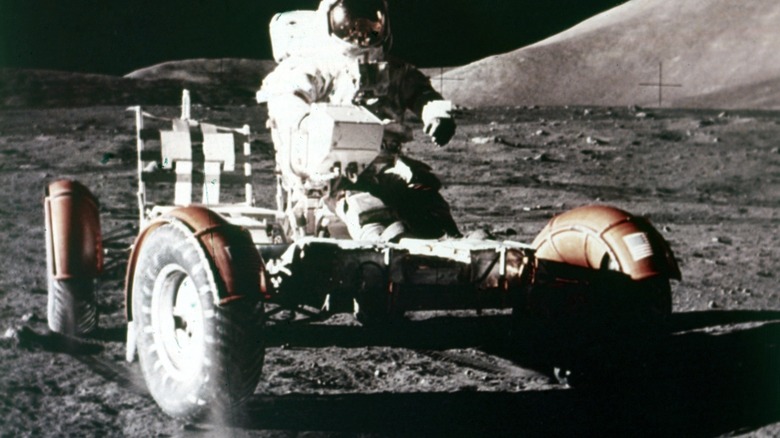The Reason Why So Many NASA Astronauts Drove Corvettes
If you weren't old enough to remember firsthand, many of NASA's legendary astronauts routinely hot-rodded around Cape Canaveral. Most of them were test pilots, so their need for speed was as much a part of their DNA as breathing.
Tom Wolfe's 1979 novel, "The Right Stuff" (turned into a hit movie a few years later), told the story of the Mercury Seven and the early days of the first NASA astronaut class. It includes tales about these fly boys racing around in Chevy Corvettes. The love affair between NASA's space jockeys and Chevy's muscle car has shown up in numerous movies and television shows over the years, from National Geographic's 2020 series based on Wolfe's book to Apple TV's "For All Mankind," a fictional take where the Russians won the space race. Even a young Captain Kirk drove a '65 Sting Ray in "Star Trek XI."
So how did America's first spacemen become associated with one of America's most iconic vehicles in the first place?
NASA astronauts love their Corvettes
On May 5, 1961, Alan Shepard navigated Freedom 7 (a Mercury spacecraft) on a suborbital flight around the Earth that lasted 15 minutes over 300 miles. While he was the second man in space after Russian Yuri Gagarin, the U.S. Navy test pilot became the first American in space.
Upon his return, General Motors president Ed Cole gave Shepard a shiny 1962 Corvette for his accomplishment. It immediately became a point of contention with both GM and NASA. GM officials thought it might set a standard for giving cars away, while NASA didn't allow astronauts to endorse products or companies. The connection might have ended right there if not for the ingenuity of Jim Rathmann, the owner of a Chevrolet-Cadillac dealership close to the Space Center in Florida. Rathmann, a gearhead and former race car driver, who had won the Indianapolis 500 in 1960, approached GM and negotiated a leasing deal for all of the Mercury astronauts. For exactly $1 a year, each of the Mercury 7 astronauts could lease the latest Corvette and trade in for a new one each year.
Six Mercury astronauts, including Gordon Cooper, Buzz Aldrin, and Gus Grissom, took Rathmann up on the offer. John Glenn went with a station wagon, claiming it benefited him and his family more. In 1969, Alan Bean (fourth man on the moon) and his fellow Apollo 12 crewmates Charles Conrad and Richard Gordon got custom gold and black Corvettes that matched the colors on their lunar module. According to Space.com, this lease program was so popular that it continued on through both the Gemini and Apollo programs and ended in 1971.
A Corvette driven by the most famous astronaut was lovingly restored
In 1969, Neil Armstrong cemented his place in history by becoming the first man to set foot on the moon's surface. Two years earlier, he was driving a 390-horsepower V8 1967 Corvette Stingray Coupe — however, it wasn't actually his car. Like many other astronauts, Armstrong was leasing the vehicle from Jim Rathmann. As with the other astronauts who took Rathmann up on his $1 deal, Armstrong was also able to trade his vehicle in a year later for a newer model. In 1968, the first man on the moon switched the Corvette Stingray Coupe for a convertible model, and the old car went back to the dealership.
The Stingray didn't stay at the dealership for long as it was soon purchased by another lower-profile NASA employee. The sale actually took place around a day after Armstrong dropped the Corvette off. From this point, the legendary coupe got quite lucky. Instead of being driven fast on dangerous roads, it had quite an easy 44 years, spending most of that time stored in a climate-controlled garage. The only modifications to the Corvette during this time were done to the rear fender flares.
Then in 2012, Corvette restorer and Sherriff's Office Commander Joe Crosby finally bought the car after reaching out to the former NASA employee several times over the years. Crosby initially thought about flipping the vehicle and put it on eBay with an astronomical reserve. A bid of over a quarter of a million dollars wasn't enough to separate Crosby from his new ride, and he decided to restore and preserve it at the behest of the National Corvette Museum. The car was displayed at the Kennedy Space Center in 2014 and regularly features at events and exhibitions.
What do you drive on the moon?
As impressive as the Corvette was, it probably wouldn't perform as well on the lunar surface. Roads aren't paved, gravity is lower, and although NASA says the moon does have an atmosphere, it has nowhere near enough oxygen to sustain the life of a person or a 427 cubic inch engine. But men have driven on the moon, and some very special vehicles were designed for that very occasion.
According to Wired, NASA's 1972 Moon Buggy — also known as the Lunar Roving Vehicle — cost $38 million, was electrically powered, and weighed just 460 pounds while sitting on Earth. Despite its light weight, the roving vehicle can carry over half a ton of samples and passengers. Corvettes were also faster, of course. The Moon Buggy doesn't really have a 0 to 60 speed and was expected to hit around 8 mph flat out. However, one was clocked going almost 12 mph, exceeding all expectations. Moon Buggies accompanied space crews on three missions: Apollo 15, Apollo 16, and Apollo 17. Despite the price, the buggies were also single-use and the crews left them behind on the lunar surface following their mission's completion. Only six people got to ride the buggy across the lunar surface, but a new generation of astronauts may soon know what it's like to drive around on Earth's largest natural satellite.
The next pair of wheels to leave tire marks on the moon is likely to be more advanced. Last year, NASA put out a call to private companies, asking for design ideas and input on the vehicle that will help astronauts navigate the lunar surface on future missions. Although details on the project are scarce, NASA's statement promises that its next lunar vehicle will not be "your grandfather's Moon Buggy."


